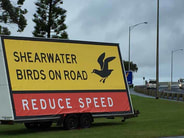
“Shearwater birds on road. REDUCE SPEED!” the electronic sign warns as we approach the bridge to Phillip Island. The young birds are often found, grounded and bewildered, waddling on the bridge after their first attempt at flying comes to grief.
There is a “No Dogs” sign at the carpark. This is a sanctuary for shearwaters and hooded plovers. Another sign tells me that three plovers were fledged on this beach in the past breeding season, and 12 altogether on Phillip Island. It doesn’t sound promising for a threatened species but some years the tally is zero due to the presence of foxes, dogs, cats, king tides and other dangers. So 12 young birds is good.
At least the foxes are gone from Phillip Island, or so Phillip Island Nature Parks believes. That leaves dogs and their humans as their main threat, and a dedicated team of plover lovers patrol breeding beaches along Bass Coast cautioning owners to put their dogs on a lead and make a wide berth around nesting sites.
I try explaining all this to Matilda, our dog, but she still lets out a plaintive howl from the car as we climb the steps to the top of the sand dunes and disappear from her view.
She has a point. I think the shearwaters have left, and breeding season for the plovers is over. Still, there are other places where she can roam.
The beach is beautiful … and deserted. No sign of plovers or shearwaters. Later my friend Linda Cuttriss, who lives on the island next to a shearwater rookery, confirms that the young shearwaters left just a few days earlier on their long migration to the coasts off Alaska.
“There were a lot of frantic footprints outside the burrows in the lead-up to late last week when the big winds and rain came on Thursday and Friday. They always wait for a big wind to get them going – a westerly or south-westerly to push them eastward along Bass Strait and back to the Aleutian Islands in the Bering Sea off Alaska. A long way to go especially when you’ve never been there before and your parents have already left.”
Linda also remarks that this year she hasn’t seen many carcasses of young shearwaters. Some years the beaches are littered with them, a heart-breaking sight. A report in Saturday’s Age notes that the bellies of many of these young shearwaters are found to contain plastic items – bottle tops, plastic toys – that the adult birds have mistakenly fed to their young. The malnourished chicks can barely fly, let alone tackle the vast journey to Alaska.
I wonder whether “our” shearwaters have arrived at their destination yet, and how they are getting on up there. It’s coming on for summer in the northern hemisphere but that doesn’t mean they are headed for a tropical paradise. This week’s forecast for the Aleutian Islands is for wind and rain, with temperatures ranging between 2 and 8 degrees on Saturday.
On the way home from Forrest Caves, we call into San Remo. In front of the Fisherman’s Co-op, I spot a sign. “Mutton bird. A whole bird, grilled to perfection, served with garden salad and sweet chilli sauce. $19.50”
In case you don’t know, shearwaters and mutton birds are one and the same. Not 100 metres from the sign asking motorists to slow for the shearwaters, they’re serving them up to tourists!
My old neighbour Jim Bell (now sadly departed) once told me that people used to wait at the bridge for the young birds to crash land, then grab them and stuff them in a sack to take home for the pot. The target was always the big fat juicy baby shearwaters as they are all plumped up and ready for the big flight.
But you had to keep an eye out for the law. “Even if you pick up a dead mutton bird, you get fined just as much as if you caught one,” Jim said.
“There was all sorts of schemes went on. A friend of mine, a cop – he’s dead now – used to go mutton birding on Anzac Day because the inspectors were all returned men. They got good jobs with the Protected Game and they’d all be away at the Anzac march. So they’d go over in the daytime pinching the birds. That was the free day. Every bugger’d be over there.”
The taste is not for everyone, as Jim explained. “You wouldn’t want to eat them every day, but they had a flavour all of their own. They lived on fish and that’s what made them rich. They’re beautiful. They’re only a little bird, about as big as a domestic pigeon.
Jim’s wife Dot used to prepare them, complaining all the while at the fishy smell. “She’d season them and roast them, then let them get cold. I couldn’t eat them hot, they were too oily, greasy hot. I’d have them the next day.”
Many years after that interview with Jim, I look at the bridge and I look at the co-op, not 100 metres away, and I think … surely not.
The truth is more mundane. Killing mutton birds on Phillip Island remains illegal. However, there is limited commercial harvesting of young mutton birds from islands in the Bass Strait by local Aboriginal groups, who process the birds and send them to the mainland.
For what it’s worth, it’s not our mutton birds the co-op is serving with a garden salad and chilli sauce.
Phillip Island Nature Parks: Shearwater update